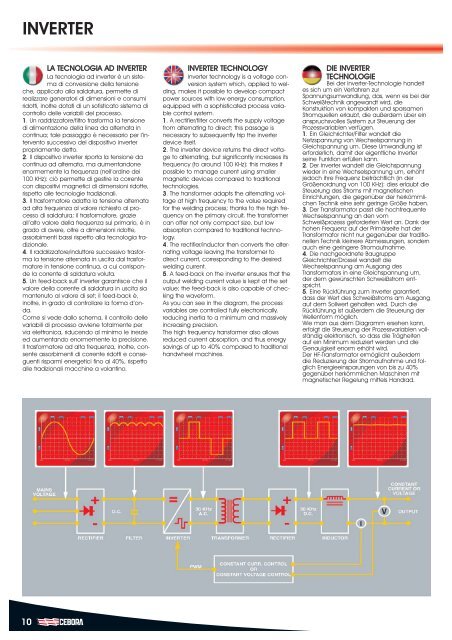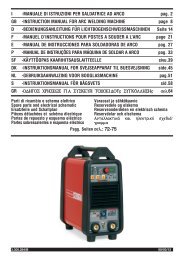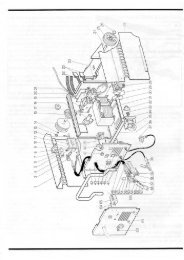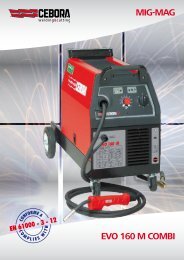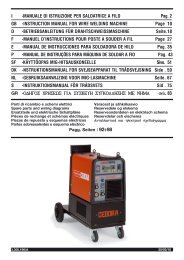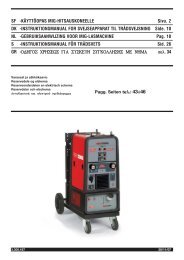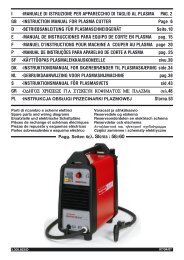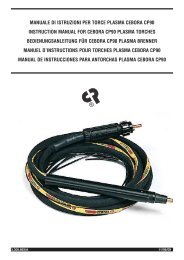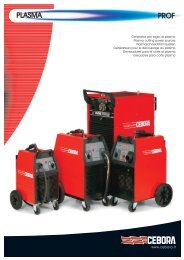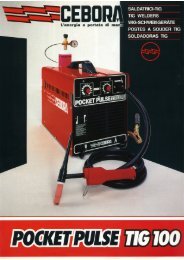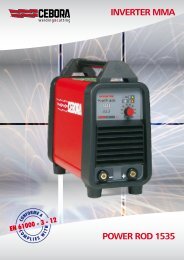Catalogo Inverter MMA-TRIFASI-C284:Catalogo ... - Cebora S.p.A.
Catalogo Inverter MMA-TRIFASI-C284:Catalogo ... - Cebora S.p.A.
Catalogo Inverter MMA-TRIFASI-C284:Catalogo ... - Cebora S.p.A.
You also want an ePaper? Increase the reach of your titles
YUMPU automatically turns print PDFs into web optimized ePapers that Google loves.
INVERTER<br />
LA TECNOLOGIA AD INVERTER<br />
La tecnologia ad inverter è un sistema<br />
di conversione della tensione<br />
che, applicato alla saldatura, permette di<br />
realizzare generatori di dimensioni e consumi<br />
ridotti, inoltre dotati di un sofisticato sistema di<br />
controllo delle variabili del processo.<br />
1. Un raddrizzatore/filtro trasforma la tensione<br />
di alimentazione della linea da alternata in<br />
continua; tale passaggio è necessario per l’intervento<br />
successivo del dispositivo inverter<br />
propriamente detto.<br />
2. Il dispositivo inverter riporta la tensione da<br />
continua ad alternata, ma aumentandone<br />
enormemente la frequenza (nell’ordine dei<br />
100 KHz): ciò permette di gestire la corrente<br />
con dispositivi magnetici di dimensioni ridotte,<br />
rispetto alle tecnologie tradizionali.<br />
3. Il trasformatore adatta la tensione alternata<br />
ad alta frequenza al valore richiesto al processo<br />
di saldatura; il trasformatore, grazie<br />
all’alto valore della frequenza sul primario, è in<br />
grado di avere, oltre a dimensioni ridotte,<br />
assorbimenti bassi rispetto alla tecnologia tradizionale.<br />
4. Il raddrizzatore/induttore successivo trasforma<br />
la tensione alternata in uscita dal trasformatore<br />
in tensione continua, a cui corrisponde<br />
la corrente di saldatura voluta.<br />
5. Un feed-back sull’ inverter garantisce che il<br />
valore della corrente di saldatura in uscita sia<br />
mantenuto al valore di set; il feed-back è,<br />
inoltre, in grado di controllare la forma d’onda.<br />
Come si vede dallo schema, il controllo delle<br />
variabili di processo avviene totalmente per<br />
via elettronica, riducendo al minimo le inerzie<br />
ed aumentando enormemente la precisione.<br />
Il trasformatore ad alta frequenza, inoltre, consente<br />
assorbimenti di corrente ridotti e conseguenti<br />
risparmi energetici fino al 40%, rispetto<br />
alle tradizionali macchine a volantino.<br />
10<br />
INVERTER TECHNOLOGY<br />
<strong>Inverter</strong> technology is a voltage conversion<br />
system which, applied to welding,<br />
makes it possible to develop compact<br />
power sources with low energy consumption,<br />
equipped with a sophisticated process variable<br />
control system.<br />
1. A rectifier/filter converts the supply voltage<br />
from alternating to direct; this passage is<br />
necessary to subsequently trip the inverter<br />
device itself.<br />
2. The inverter device returns the direct voltage<br />
to alternating, but significantly increases its<br />
frequency (to around 100 KHz): this makes it<br />
possible to manage current using smaller<br />
magnetic devices compared to traditional<br />
technologies.<br />
3. The transformer adapts the alternating voltage<br />
at high frequency to the value required<br />
for the welding process; thanks to the high frequency<br />
on the primary circuit, the transformer<br />
can offer not only compact size, but low<br />
absorption compared to traditional technology.<br />
4. The rectifier/inductor then converts the alternating<br />
voltage leaving the transformer to<br />
direct current, corresponding to the desired<br />
welding current.<br />
5. A feed-back on the inverter ensures that the<br />
output welding current value is kept at the set<br />
value; the feed-back is also capable of checking<br />
the waveform.<br />
As you can see in the diagram, the process<br />
variables are controlled fully electronically,<br />
reducing inertia to a minimum and massively<br />
increasing precision.<br />
The high frequency transformer also allows<br />
reduced current absorption, and thus energy<br />
savings of up to 40% compared to traditional<br />
handwheel machines.<br />
DIE INVERTER<br />
TECHNOLOGIE<br />
Bei der <strong>Inverter</strong>-Technologie handelt<br />
es sich um ein Verfahren zur<br />
Spannungsumwandlung, das, wenn es bei der<br />
Schweißtechnik angewandt wird, die<br />
Konstruktion von kompakten und sparsamen<br />
Stromquellen erlaubt, die außerdem über ein<br />
anspruchsvolles System zur Steuerung der<br />
Prozessvariablen verfügen.<br />
1. Ein Gleichrichter/Filter wandelt die<br />
Netzspannung von Wechselspannung in<br />
Gleichspannung um. Diese Umwandlung ist<br />
erforderlich, damit der eigentliche <strong>Inverter</strong><br />
seine Funktion erfüllen kann.<br />
2. Der <strong>Inverter</strong> wandelt die Gleichspannung<br />
wieder in eine Wechselspannung um, erhöht<br />
jedoch ihre Frequenz beträchtlich (in der<br />
Größenordnung von 100 KHz): dies erlaubt die<br />
Steuerung des Stroms mit magnetischen<br />
Einrichtungen, die gegenüber der herkömmlichen<br />
Technik eine sehr geringe Größe haben.<br />
3. Der Transformator passt die hochfrequente<br />
Wechselspannung an den vom<br />
Schweißprozess geforderten Wert an. Dank der<br />
hohen Frequenz auf der Primärseite hat der<br />
Transformator nicht nur gegenüber der traditionellen<br />
Technik kleinere Abmessungen, sondern<br />
auch eine geringere Stromaufnahme.<br />
4. Die nachgeordnete Baugruppe<br />
Gleichrichter/Drossel wandelt die<br />
Wechselspannung am Ausgang des<br />
Transformators in eine Gleichspannung um,<br />
der dem gewünschten Schweißstrom entspricht.<br />
5. Eine Rückführung zum <strong>Inverter</strong> garantiert,<br />
dass der Wert des Schweißstroms am Ausgang<br />
auf dem Sollwert gehalten wird. Durch die<br />
Rückführung ist außerdem die Steuerung der<br />
Wellenform möglich.<br />
Wie man aus dem Diagramm ersehen kann,<br />
erfolgt die Steuerung der Prozessvariablen vollständig<br />
elektronisch, so dass die Trägheiten<br />
auf ein Minimum reduziert werden und die<br />
Genauigkeit enorm erhöht wird.<br />
Der HF-Transformator ermöglicht außerdem<br />
die Reduzierung der Stromaufnahme und folglich<br />
Energieeinsparungen von bis zu 40%<br />
gegenüber herkömmlichen Maschinen mit<br />
magnetischer Regelung mittels Handrad.


